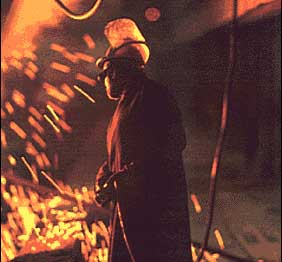Iron and Steel Overview: Labor Issues
|
Courtesy of Gas Research Institute Digest. |
Canadian Iron and Steel Industry
Employment and Productivity
Energy Consumption
Environmental Issues
Industry Modernization and Restructuring
Integrated Mill Business Structure
International Competition
Labor Issues
Market Drivers
Price Trends
Products and Markets
Regulations and NOx Control
Rolling Mills / Secondary Finishing
Sales Revenue and Profitability
Shipments by Major Markets
Shipments by Type of Market
Shipments by Type of Product
U.S. Share of World Output
U.S. Steel Shipments
The industry has become much more labor efficient improving from over 11 hours per ton of steel produced in the 1970s to 3 man-hours per ton in 1993. Nevertheless, the industry is facing significant labor issues including rising health care costs, under-capitalized pension plans, and re-engineering of labor-managment organization and responsibilities.
Between 1985 and 1993, total hourly employment costs, including health insurance rose by 40%, while hourly health care costs rose by 106%. These cost increases threaten competitiveness of the integrated producers versus international producers and also versus the less organized minimill segment. This problem is exacerbated by an accounting standards change in 1993 that requires expected future health care requirements for retirees to be recognized as a current expense. In an effort to control these costs, the major steel producers are encouraging HMOs (health maintenance organizations) and, in some cases, have actually built and are operating family medical centers.
Pension plan liabilities have exerted a big drain on corporate profits as an industry with historical employment of over 500,000 employees attempts to support union negotiated pensions for these past workers out of much reduced current operations. In at least one instance, Armcos joint venture with Kawasaki, part ownership of the venture was transferred to the pension plan itself.
The United Steelworkers of America renegotiated most of their contracts during 1993-94 with an emphasis on workplace organization, corporate behavior, and economic issues. Workplace organization goals include greater worker involvement in operation decisions and a reduction in the ratio of supervisors to workers. Corporate behavior includes successship guarantees, revitalized apprenticeship and training programs, and involvement in corporate strategic planning. Economic issues include wages, long term agreements, guarantees against layoffs and against cuts in health care and pension programs. Many of the wage increases are tied to productivity and profitability indices. One fallout of the new “no-layoff” contracts is to create greater price competition in the steel markets as producers strive to maximize production to cover their “fixed” labor cost.
Steel Semiannual Monitoring Report, U.S. International Trade Commission, Publication 2878, April 1995.
Paul J. Wilhelm (President, U.S. Steel Group), “Managing Change in the Steel Industry”, Iron and Steel Engineer, August 1995.

